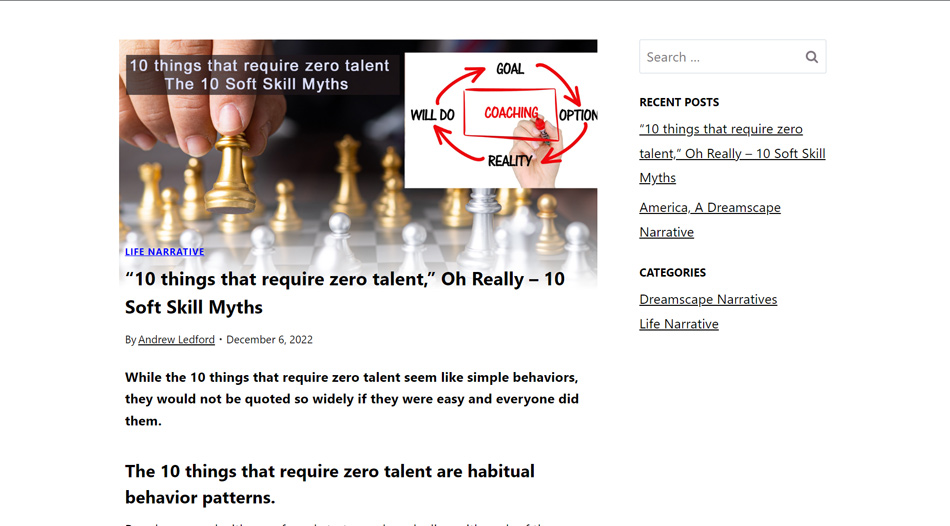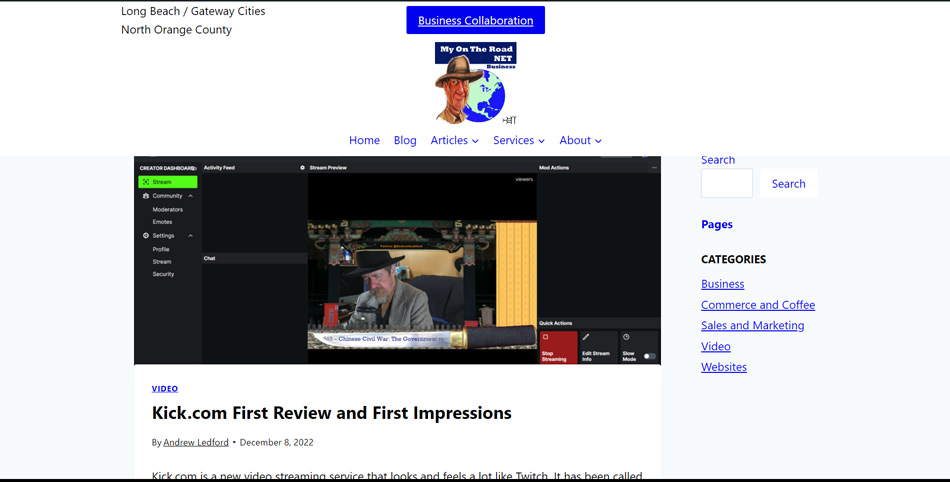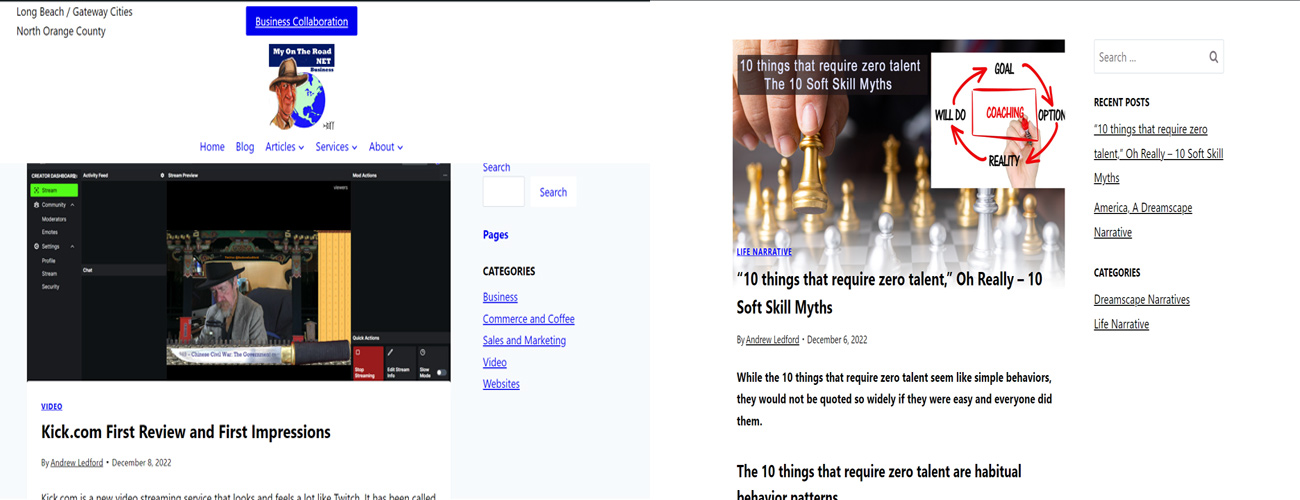Blogging, The Tale of Writing Two Blog Posts
I have been writing blog posts for some time and writing in general even longer. I remember writing my first little book with illustrations when I was in third grade. I don’t know if I am a good writer, but apparently I like to write. After writing two very different blog posts I thought it may be good to take a closer look at the motivation for writing and the process.
Writing a blog post involves a lot more than just writing the actual words.
It is best practice to have an editorial calendar where you have regular blog posts planned. However, you need to also have room to do writing that is inspired by serendipitous opportunity. It is serendipity that inspired the two blog posts I am to discuss.
Fist is the 10 things that require zero talent,” 10 Soft Skill Myths. I was on a LinkedIn group and saw a post that was just a few words long with a 10 things graphic. Well, it got me thinking, you know, those 10 things really are talents or at least skills.
When starting the 10 things I was unsure which website I would post it on. While the 10 things are desirable skills for work, they are also useful in many areas of life. Through the writing process I decided they belonged on my Heavens Banquet website. They really are life skills that impact one’s life narrative.

What is the blog’s purpose?
Part of the blogging process is knowing where and how you will use the blog. In other words, what is the blog’s purpose? The 10 things that require zero talent post is meant to help people understand how traits that are taken for granted are really skills that can improve one’s life. So the blog post is about self-development.
Out of all my websites, which one is about self-development? Heavens Banquet. It could have easily been used on this site, because the 10 things that require zero talent are workplace skills as well. The purpose of that blog post is to show that the 10 things are both personal traits and to some extent learnable skills.
I started writing the article with an introduction and outline. Then I added the 10 things I was writing about and worked on the first graphic.
Over the next couple of days I would write a little about each of the 10 points. While I like to write, I don’t write fast. I usually write about 500 to a 1500 words at a time. After I’m all written out, I need a little break before I have more to say.
As I write I’m referencing my episodic, semantic, and procedural memories. Yes I am using past experience, my observations, and research I’ve studied and done, to shed light on a misunderstood subject.
One of the reasons people think the 10 things take no talent is because they have never really given them much thought. If you examine many of our habitual behaviors you’ll find they do have an origin.
Our day in and day out behaviors are either part of our genetic endowment or were learned through interacting with the environment. However, it is very common that they are a combination of both genetic inheritance and environmental influences.
If they are learned and maintained through the environment then we can more easily develop them. In addition we can also develop processes to help maintain them. This last point is useful for businesses to consider when developing workplace policies.
While using positive reinforcement to influence behavior is a pleasant way to encourage this kind of behavior, it’s not very business-like. Most businesses are quite adversarial and will want to use threats and punishment to coerce employee behavior. Being aversive does not always make people want to help you. This is true even if you provide complex reward systems. In Fact complex reward systems can create undesirable working conditions that are not in the best long term interest of the company.
Once I finished most of the post I started developing the video assets for the blog post. There are many short scenes in each video and I decided to use stock footage for these. As I was working on the videos I also went back and refined the article.
After doing the videos and post refinement, I spent a day or so doing some proofreading. I noticed that Google docs auto spell correction was not as good as it used to be and there were several unusual words in the post. While writing the current post it looks like they have fixed some of the issues encountered when writing the 10 things post.
It took seven days to go from blog post idea to finished blog post. But the blogging process wasn’t finished yet. I still need to publish the blog post and promote it.
Publishing and promoting the blog post is an important part of blogging.
I finished the post on a Sunday, however I waited until Tuesday to publish it. Holding off on publishing the post also gave it a day to rest, which lets me see it more clearly. It’s always easier to see typos after not looking at a piece of writing for some time. The day of posting I did a final proofread. I find it difficult to proofread my own writing. Even not looking at my writing for a short period, such as a day, will make spotting errors easier.
I postponed publishing the article for a day because I wanted to post it on LinkedIn on Tuesday morning.
I feel like there are too many new posts on Mondays. Posting it on Tuesday also gave me enough time to post it on other social sites and in groups in an orderly manner.
The same day I posted it to most of my other social sites as well. It took seven day from getting the idea to completing the blog post. If we take into account the social posting and promotion, the blog post took about 17 days from idea to promotion and I’m not done yet. In addition to posting on social media I also did a live stream video about the post. The video recording of the live stream will be repurposed into longer as well as short form video. Seeing that the post you’re reading now is part of the promotion, I’m still not finished. It will take several days after I publish this post before I am done with this phase.
The tale of writing blog post number two.
Post number 2 was also inspired by something I read on LinkedIn. One of the people I’m following mentioned a new streaming service much like Twitch.

Kick.com blog post
This blog post was much different and required different skills. On the same day that I heard about the new streaming service I signed up. That evening I went live and streamed for about 30 minutes. The next day I got up well before sunrise to write the blog post and make graphics for the new account. In the very early morning I also finish filling out the profile and setting up the account. Then I did a few more live streams. The morning live streams were more like tutorials. I also needed to get some screen shots of the interface for additional graphics.
In the beginning there were a few confusing glitches between my OBS software and the Kick platform. Both the confusion and glitches can be avoided by following Kick’s recommended go live guidelines.
Then I edited the graphics and built and formatted the post. Added meta tags and other aspects of blog design.
Next I added the videos. I had quite a few videos to edit. Out of all the video files, I ended up with three videos for the blog post.
I uploaded the videos to my video server. Each video needs to be configured after it is uploaded and processed by the video platform.
Next I added the videos to the blog post. I was also refining the post throughout the day.
This blog post was much quicker to write and put together than the 10 things post. I started in the early evening and finished the next day. I figure it took about a total of 15 hours to build the post. The next day I published the post and started sharing it right away.
I felt this post was more time sensitive than the 10 things post and would have shared it no matter what day it was finished. Actually I did go back to refine and added more to the post over the next couple of days. So in reality it took more than 15 hours.
I usually recommend using an outline when compiling a blog post. I used an outline for the 10 things that require zero talent, then modified the copy a bit for the Heavens Banquet site. I did not have a formal outline for the Kick.com blog post. For the Kick post I used the chronological order of events as the outline. For the post you are reading I had the loosest of outlines and did more of a stream of consciousness dump. This post probably could have been better organized if I would have used a well-structured outline. However, I enjoyed writing it the way I did.
I used a standard posting strategy with the Kick post. Whereas with the 10 things post I had a more planned and measured posting strategy. They are two different kinds of blogs and I used different promotion strategies with each.
A big difference in these two blog posts is that one, the Kick post, was simply a description of what was done. It was a narrative of a recent experience and only needed to document the experience. The other required critical thinking.
The 10 things blog post pulled together a wide assortment of diverse information, processed it, and formed a logical hypothesis about the no talent vs talent argument. The 10 things post required a certain amount of evidence, and rationalization. It required a certain degree of familiarity with several psychological and physiological concepts.
Many of the concepts found in the 10 things post were originally developed using animal models. Some examples are operant conditioning that teaches us how reinforcement works and classical conditioning that illustrates more reflexive behaviors. In addition, animal models have been instrumental in learning about emotional states involving stress and fear.
There are many similarities between the behavioral mechanisms of most mammals. These are considered mammalian behaviors. Of course there are the more complex behaviors of humans. But human behavior is built on top of other mammalian behavior. Just like the 10 things, many people believe myths about human behavior, the one I encounter a lot is that human behavior has nothing to do with animal behavior.
Are you familiar with how influential the work of B. F. Skinner and Pavlov have been on developing training and teaching programs for people? They did most of their work learning how behavior works by teaching animals. This is the foundation, if not the primary concept, underlying the Lucid Lerner Lab project I’m working on.
Language is of special interest and so is the human capacity for abstract thought. While I am familiar with the idea that language can transcend and extend reinforcement theory, I’m exploring newer concepts.
I think we may be able to gain a much better, but not necessarily more practical, understanding of behavior by looking at artificial intelligence. I am interested in how artificial intelligence processes information and then uses that information for some action. There are artificial intelligence models that are applicable to modeling biological information processing and acting. As I read more about this you will most likely see it creep into my writing.

